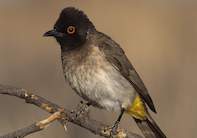
Name
African red-eyed bulbul - Pycnonotus nigricans
Alternative name red-eyed bulbul
African Red-eyed Bulbul Appearance
The African red-eyed bulbul has greyish/brown plumage on its upper parts, extending onto the chest, with white plumage on their underparts. The head is darker with a crest on the top of the head. A bright yellow vent is visible. The eyes are dark, bill, legs and feet are black. A conspicuous orange to red eye ring surrounds the eye. This is a smallish bird at 20 cm, with males being slightly larger than females.
Easily distinguished from the dark-capped bulbul by the red eye ring.
Diet
The red-eyed bulbul mainly eats fruit, but will hawk insects occasionally. At certain times of the year, they feed on nectar and flower petals, making them important pollinators.
African Red-eyed Bulbul Breeding
African red-eyed bulbuls are monogamous. The female builds a cup nest, always well concealed in foliage, using dry grass and twigs. The two to 3 eggs are incubated for around 15 days. The Jacobin robin brood parasite the African red-eyed bulbul.
The African red-eyed bulbul will breed with the dark-capped bulbul and the Cape bulbul, forming hybrids, in areas where their ranges overlap.
African Red-eyed Bulbul Behaviour
African red-eyed bulbul are normally seen in pairs or small groups. During the breeding season, the red-eyed bulbul is territorial.
Threats
None, very common across its range.
African Red-eyed Bulbul Distribution and Habitat
The African red-eyed bulbul is a near endemic, and is found in central and western parts of South Africa. It is absent from the eastern side and most of the Western Cape. This birds preferred habitat is arid to semi-arid woodlands along drainage lines. This bulbul is common in urban gardens and parks. They are never far from water and their range has extended with the provision of livestock water points.